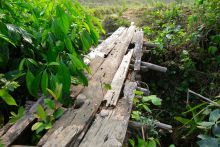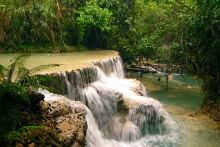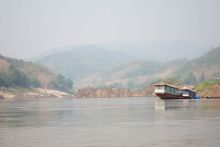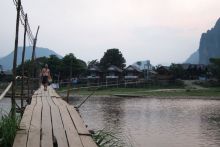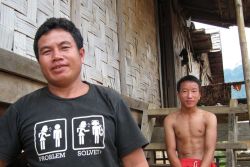The infrastructure of Laos reflects the national mentality. Bridges are flimsy and shattered or just nonexistent. The quality of roads is not any better, narrow and battered. On a positive side, most of the people in Laos drive slowly unlike Thai daredevils. Many dirt roads are not passable during the wet season. It sill remains a mystery to me how people get from one place to another during this time. Maybe they just do not? There is no sense of aesthetics whatsoever. Villages are dirty and ugly looking. Trash is left on the ground and there is not even an attempt to hide it. Poverty aside, bamboo huts in Thailand are as basic as Lao ones, but there is a charm and a sense of style in them. I saw only one tidy and pretty-looking ethnic village, but it was that way for a reason, namely it was a tourist attraction. Step out of it and walk 20 meters away and you see all the piles of garbage. Lao villages reminded me of Russian ones, in terms of dirtiness and lack of aesthetic considerations. On the other hand, Laotians have one huge advantage Russians lack, namely laid-back and easy-going lifestyle.
Without a doubt Laos’s biggest assets is its pristine nature. Laos is the land of mountains, caves, rivers, waterfalls and the most beautiful clouds I have ever seen. I do not know how Laotians do it, but clouds in Laos are vastly superior in terms of eye-candy to the neighboring Thailand and Vietnam. Some sights are simply stunning and many times after seeing a particularly magnificent waterfall or cave I thought that it cannot be topped only to see an even more beautiful one later. My top experiences in Laos must be Kong Lor Cave, Tat Fan waterfall and Si Phan Don. Kong Lor cave is a huge cave with a river flowing through it. The cave is some 7km long and at times is as 100m as wide and tall. A boat journey to the other side of the cave in the pitch dark with only a couple of torches is an experience I never forget. I have seen some other pretty impressive caves, but Kong Lor is THE cave. I guess if it was in another country, they would market the hell out of it, but since it is in Laos, not many tourists realize that such a wonder exists. As far as waterfalls are concerned, there are many amazing ones. The amazing Tat Kuang Si in Luang Prabang, which looks like a decoration to a fairytale than an actual real-life waterfall. The serene Tat Hang and its twins Tat Lo and Tat Suang on the outskirts of Bolaven Plateau. The massive Tat Somphamit in Si Phan Don breaking the steady of Mekong. The most ultimate one is Tat Fan in the heart of Bolaven with its massive twin water torrents falling down from the height of 120m. The moment I saw it, I realized that all other waterfalls combined are no match for that one. This is the waterfall that alone makes a trip to Laos worthwhile. Nature sights are mostly left in their original form with very little surrounding infrastructure. It is a huge contrast to China, where nature is put under control and brought to safety regulations. There are no endless series of stairs in the mountains, no cable cars, no fences and no safety precautions. If you make a wrong step or trip, the result might be potentially fatal. This is Laos.
The Laos geography is dominated by the the mighty Mekong flowing through the whole country from north to south. It is one of the world’s greatest rivers and is in fact the only one I saw to date. Now I am keen to see more. Over two days of the slow boat journey from Huay Xai to Luang Prabang, I did not see any bridges over Mekong or any other signs of the industrial age on the river itself or its banks. Only light boats and scattered primitive villages on the banks of Mekong. During my travels in Laos I saw only two bridges over Mekong, one in Vientiane and another one in Pakse. There surely must be more, but I suspect they are not many of them. It is truly amazing to see that in this age such a great river has escaped the fate of industrialization. Thanks to the low population density and the rural lifestyle, Laos still sports mostly untouched nature, but it is changing. Hydrodams are being built, there is deforestation going on and slash & burn farming tactics are prevalent leaving ugly scars on green hills. The air in Luang Prabang was full of smoke and ash, which I thought was due forest fires, but only later realized it was a local way to farm land. Sooner or later Laos will enter the industrial age big time, either on its own (or maybe not) or with the help of its mighty neighbors as China and Vietnam (more likely) . If you would like to see the pristine nature of Laos, the time is now. Five, ten years later it might be too late.
